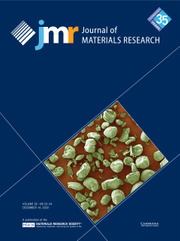Crossref Citations
This article has been cited by the following publications. This list is generated based on data provided by
Crossref.
Wang, H. Y.
Najafabadi, R.
Srolovitz, D. J.
and
Lesar, R.
1990.
The Free Energy Simulation Approach to Grain Boundary Segregation In Cu-Ni.
MRS Proceedings,
Vol. 209,
Issue. ,
Najafabadi, R.
Wang, H. Y.
Srolovitzt, D. J.
and
LeSar, R.
1990.
Free Energy Simulation of Grain Boundary Segregation and Thermodynamics In Ni3−xAl1+x.
MRS Proceedings,
Vol. 213,
Issue. ,
Najafabadi, R.
Srolovitz, D.J.
and
LeSar, R.
1991.
Thermodynamic and structural properties of [001] twist boundaries in gold.
Journal of Materials Research,
Vol. 6,
Issue. 5,
p.
999.
Najafabadi, R.
Wang, H.Y.
Srolovitz, D.J.
and
LeSar, R.
1991.
A new method for the simulation of alloys: Application to interfacial segregation.
Acta Metallurgica et Materialia,
Vol. 39,
Issue. 12,
p.
3071.
Najafabadi, R.
Wang, H.Y.
Srolovitz, D.J.
and
LeSar, R.
1991.
The effects of segregation on grain boundary cohesive energies in Ni3−xAl1+x.
Scripta Metallurgica et Materialia,
Vol. 25,
Issue. 11,
p.
2497.
LeSar, R.
Najafabadi, R.
and
Srolovitz, D. J.
1991.
Thermodynamics of solid and liquid embedded-atom-method metals: A variational study.
The Journal of Chemical Physics,
Vol. 94,
Issue. 7,
p.
5090.
Chen, Long-Qing
and
Kalonji, Gretchen
1992.
Finite temperature structure and properties of ∑ = 5 (310) tilt grain boundaries in nacl a molecular dynamics study.
Philosophical Magazine A,
Vol. 66,
Issue. 1,
p.
11.
Zhao, L.
Najafabadl, R.
and
Srolovitz, D. J.
1992.
Methods for Determining Vacancy Formation Thermodynamic.
MRS Proceedings,
Vol. 291,
Issue. ,
Najafabadi, R.
and
Srolovitz, D. J.
1992.
Segregation to and Phase Transition at Σ5 (310)/[001] Tilt Grain Boundaries in Ni3−xAl1+x Alloys.
MRS Proceedings,
Vol. 288,
Issue. ,
Foiles, Stephen M.
1992.
Equilibrium Structure and Properties of Surfaces and Interfaces.
p.
89.
Wang, H. Y.
Najafabadi, R.
Srolovitz, D. J.
and
LeSar, R.
1992.
(100) surface segregation in Cu-Ni alloys.
Physical Review B,
Vol. 45,
Issue. 20,
p.
12028.
Nomura, Miki
and
Adams, James B.
1992.
Self-diffusion along twist grain boundaries in Cu.
Journal of Materials Research,
Vol. 7,
Issue. 12,
p.
3202.
Wang, H.Y.
Najafabadi, R.
Srolovitz, D.J.
and
Lesar, R.
1993.
Segregation to and structure of [001] twist grain boundaries in CuNi alloys.
Acta Metallurgica et Materialia,
Vol. 41,
Issue. 9,
p.
2533.
Najafabadi, R.
Srolovitz, D. J.
Ma, E.
and
Atzmon, M.
1993.
Thermodynamic properties of metastable Ag-Cu alloys.
Journal of Applied Physics,
Vol. 74,
Issue. 5,
p.
3144.
Zhao, L
Najafabadi, R
and
Srolovitz, D J
1993.
Finite temperature vacancy formation thermodynamics: local harmonic and quasiharmonic studies.
Modelling and Simulation in Materials Science and Engineering,
Vol. 1,
Issue. 4,
p.
539.
Najafabadi, R.
and
Srolovitz, D.J.
1993.
Order-disorder transitions at and segregation to (001) Ni-Pt surfaces.
Surface Science,
Vol. 286,
Issue. 1-2,
p.
104.
Udler, D.
and
Seidman, D.N.
1994.
Solute-atom segregation at (002) twist boundaries in dilute NiPt alloys: Structural/chemical relations.
Acta Metallurgica et Materialia,
Vol. 42,
Issue. 6,
p.
1959.
Swaminarayan, S.
Najafabadi, R.
and
Srolovitz, D.J.
1994.
Polycrystalline surface properties from spherical crystallites: Ag, Au, Cu and Pt.
Surface Science,
Vol. 306,
Issue. 3,
p.
367.
Seidman, D.N.
Krakauer, B.W.
and
Udler, D.
1994.
Atomic scale studies of solute-atom segregation at grain boundaries: Experiments and simulations.
Journal of Physics and Chemistry of Solids,
Vol. 55,
Issue. 10,
p.
1035.
Najafabadi, R.
and
Srolovitz, D.J.
1994.
Elastic step interactions on vicinal surfaces of fcc metals.
Surface Science,
Vol. 317,
Issue. 1-2,
p.
221.

